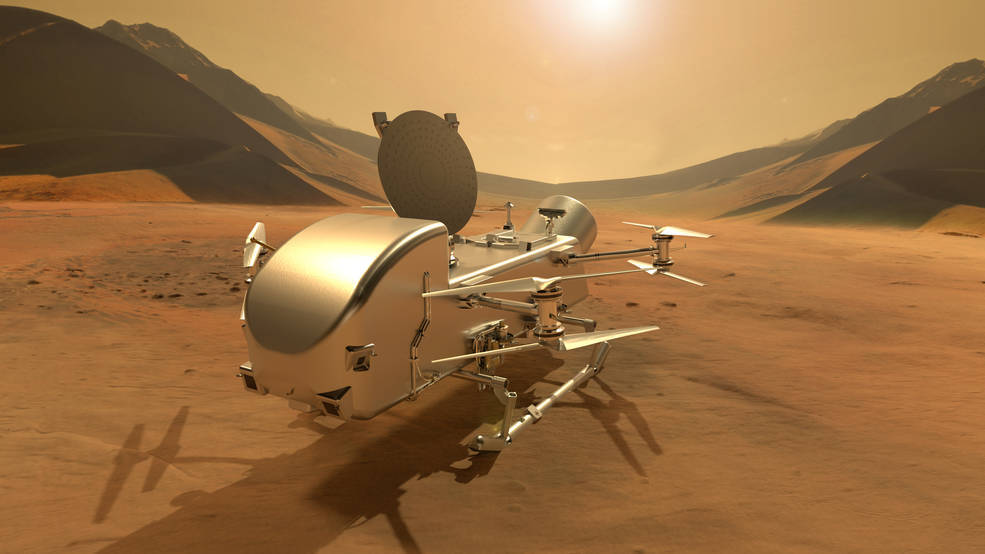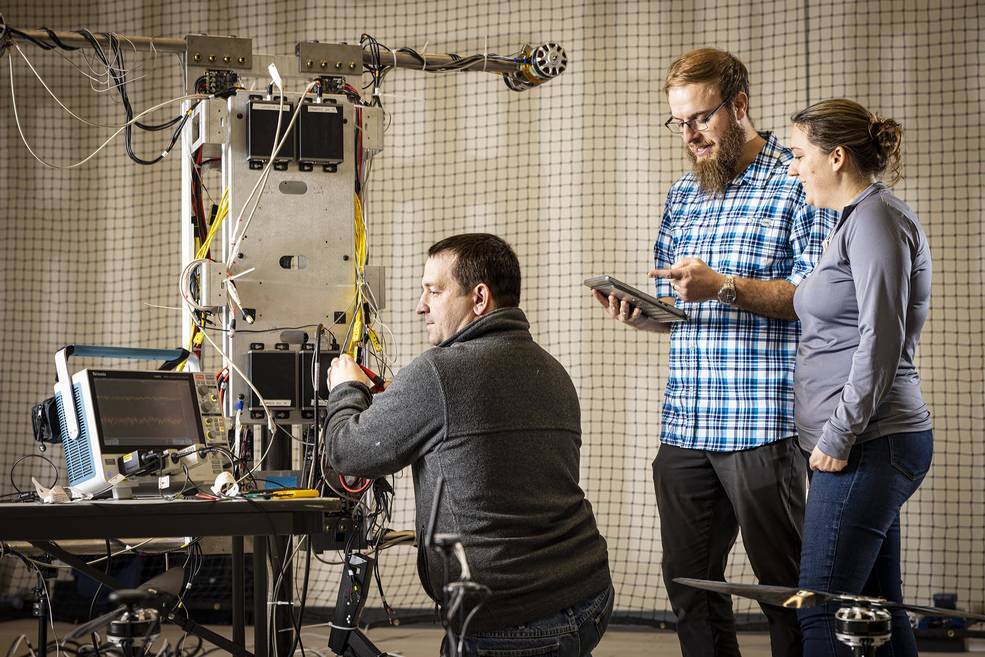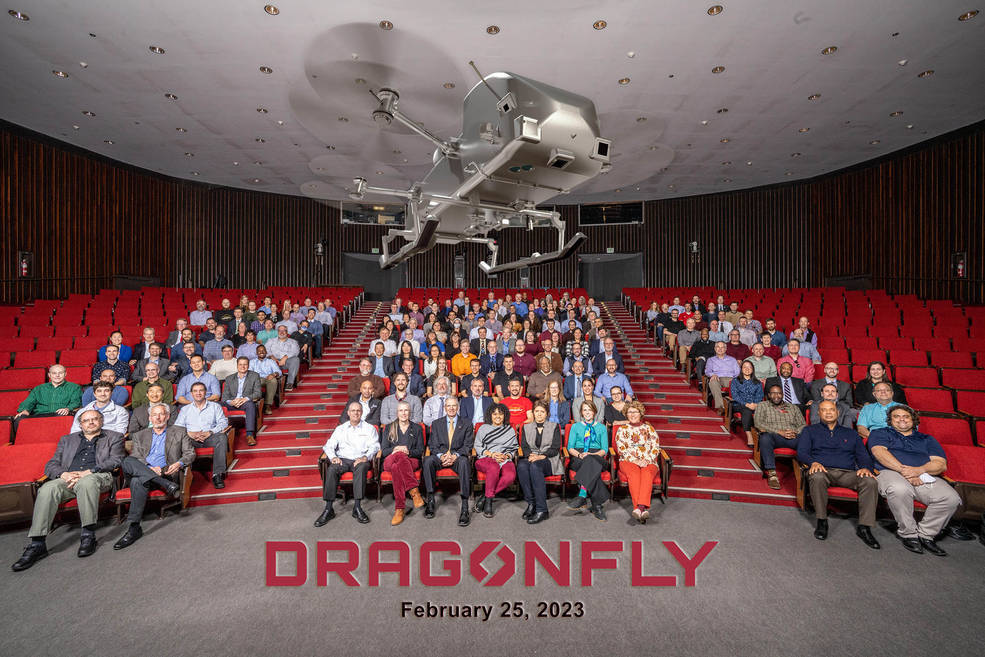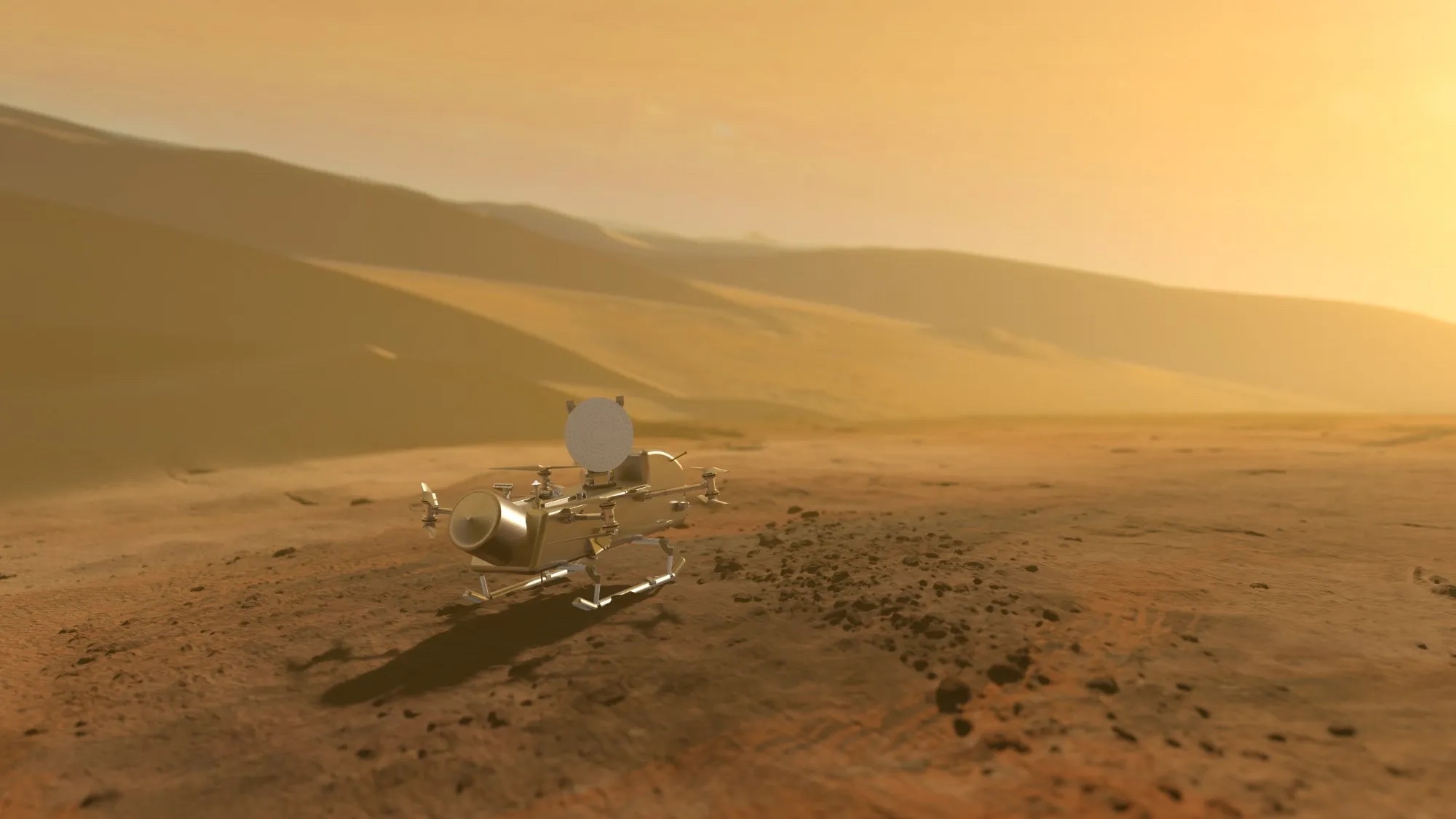NASA’s Dragonfly mission has been authorized to proceed with work on final mission design and fabrication – known as Phase C – during fiscal year (FY) 2024. The agency is postponing formal confirmation of the mission (including its total cost and schedule) until mid-2024, following the release of the FY 2025 President’s Budget Request.
Earlier this year, Dragonfly – a mission to send a rotorcraft to explore Saturn’s moon Titan – passed all the success criteria of its Preliminary Design Review. The Dragonfly team conducted a re-plan of the mission based on expected funding available in FY 2024 and estimate a revised launch readiness date of July 2028. The Agency will officially assess the mission’s launch readiness date in mid-2024 at the Agency Program Management Council.
“The Dragonfly team has successfully overcome a number of technical and programmatic challenges in this daring endeavor to gather new science on Titan,” said Nicola Fox, associate administrator of NASA’s Science Mission Directorate at NASA headquarters in Washington. “I am proud of this team and their ability to keep all aspects of the mission moving toward confirmation.”
Dragonfly takes a novel approach to planetary exploration, for the first time employing a rotorcraft-lander to travel between and sample diverse sites on Titan. Dragonfly’s goal is to characterize the habitability of the moon’s environment, investigate the progression of prebiotic chemistry in an environment where carbon-rich material and liquid water may have mixed for an extended period, and even search for chemical indications of whether water-based or hydrocarbon-based life once existed on Titan.
Dragonfly is being designed and built under the direction of the Johns Hopkins Applied Physics Laboratory in Laurel, Maryland, which manages the mission for NASA. The team includes key partners at NASA’s Goddard Space Flight Center in Greenbelt, Maryland; Lockheed Martin Space in Littleton, Colorado; Sikorsky, a Lockheed Martin company; NASA’s Ames Research Center in Silicon Valley, California; NASA’s Langley Research Center in Hampton, Virginia; Penn State University in State College, Pennsylvania; Malin Space Science Systems in San Diego, California; Honeybee Robotics in Pasadena, California; NASA’s Jet Propulsion Laboratory in Southern California; CNES (Centre National d’Etudes Spatiales), the French space agency, in Paris, France; DLR (German Aerospace Center) in Cologne, Germany; and JAXA (Japan Aerospace Exploration Agency) in Tokyo, Japan. Dragonfly is the fourth mission in NASA’s New Frontiers Program, managed by NASA’s Marshall Space Flight Center in Huntsville, Alabama, for the Science Mission Directorate.
Quelle: NASA
----
Update: 27.11.2024
.
NASA's nuclear-powered Dragonfly helicopter will ride a SpaceX Falcon Heavy rocket toward Saturn moon Titan
The Dragonfly rotorcraft will ride a Falcon Heavy into space in July 2028, kicking off a six-year journey to Titan.
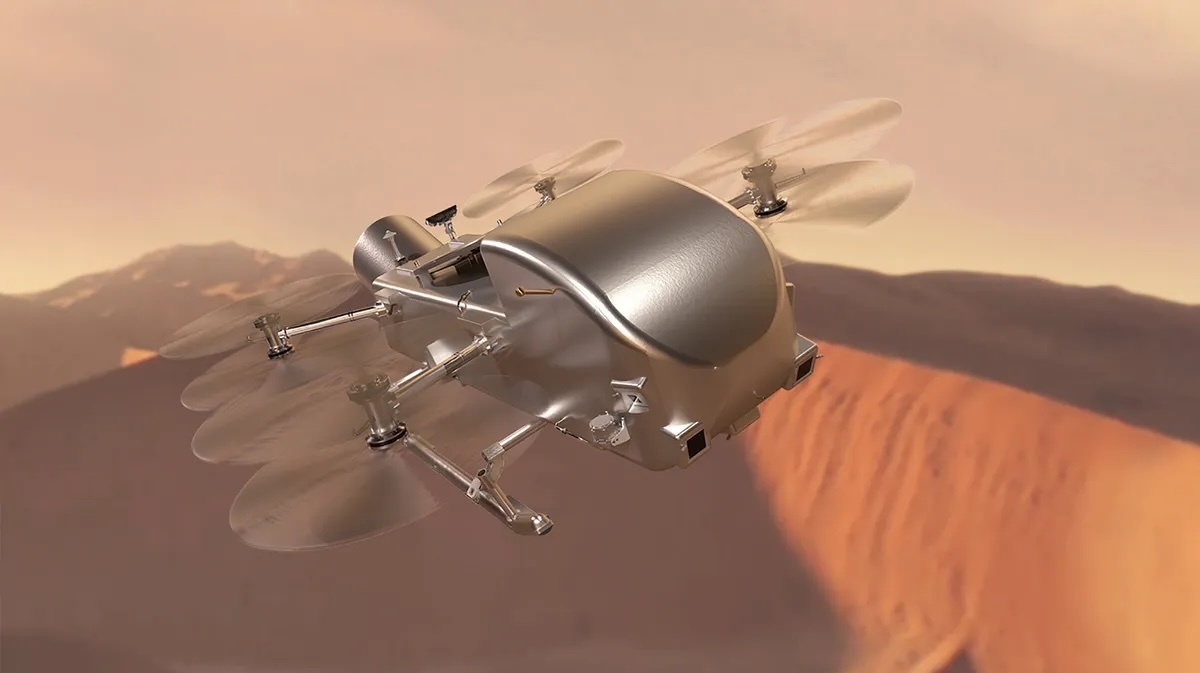
An illustration of NASA's Dragonfly rotorcraft soaring in the skies of Saturn’s largest moon, Titan. (Image credit: NASA/Johns Hopkins APL/Steve Gribben)
SpaceX's powerful Falcon Heavy rocket will launch yet another high-profile NASA science mission.
The agency announced today (Nov. 25) that it has picked the Falcon Heavy to loft Dragonfly, a $3.35 billion mission that will investigate the life-hosting potential of Saturn's huge moon Titan. The burly rocket also launched NASA's Psyche asteroid probe and Europa Clipper spacecraft, in October 2023 and October 2024, respectively.
The Dragonfly contract is a firm, fixed-price deal with a value of nearly $257 million, "which includes launch services and other mission-related costs," NASA officials wrote in an update this afternoon.
If all goes according to plan, Falcon Heavy will launch the car-sized Dragonfly rotorcraft during a three-week window in July 2028. The spacecraft will then spend six years making its way to Titan, the second-largest moon in the solar system (after Jupiter's Ganymede).
Titan's size isn't its only intriguing characteristic. The frigid satellite hosts seas and lakes of hydrocarbons, making it the only body beyond Earth known to host stable liquids on its surface. In addition, organic compounds, the carbon-containing building blocks of life as we know it, are common on the world.
Some scientists therefore think Titan may be capable of supporting life — perhaps on its alien surface or in its suspected subterranean ocean of liquid water. Dragonfly is designed to investigate this question, and to shed light on a little-studied world more generally.
"With contributions from partners around the globe, Dragonfly’s scientific payload will characterize the habitability of Titan's environment, investigate the progression of prebiotic chemistry on Titan, where carbon-rich material and liquid water may have mixed for an extended period, and search for chemical indications of whether water-based or hydrocarbon-based life once existed on Saturn’s moon," NASA officials wrote in today's update.
The nuclear-powered rotorcraft will operate for about 2.5 Earth years on Titan's surface, flitting from place to place to get an in-depth look at a variety of landscapes.
Dragonfly has experienced delays and cost increases during its development. When NASA originally selected the mission in 2019, for example, its cost was capped at $1 billion, and launch was targeted for 2027.
Such issues are far from uncommon on ambitious exploration efforts such as Dragonfly. And the mission has made significant progress recently; it remains on track for its current 2028 launch target, NASA announced earlier this year.
Falcon Heavy is the second-most-powerful rocket currently in operation, after NASA's Space Launch System moon rocket (though SpaceX's Starship megarocket will claim the title when it comes online). Falcon Heavy has launched 11 times to date, most recently sending Europa Clipper toward Jupiter's ocean moon Europa on Oct. 14.
Quelle: SC
----
Update: 24.05.2025
.
NASA’s Dragonfly Mission Sets Sights on Titan’s Mysteries
When it descends through the thick golden haze on Saturn’s moon Titan, NASA’s Dragonfly rotorcraft will find eerily familiar terrain. Dunes wrap around Titan’s equator. Clouds drift across its skies. Rain drizzles. Rivers flow, forming canyons, lakes and seas.
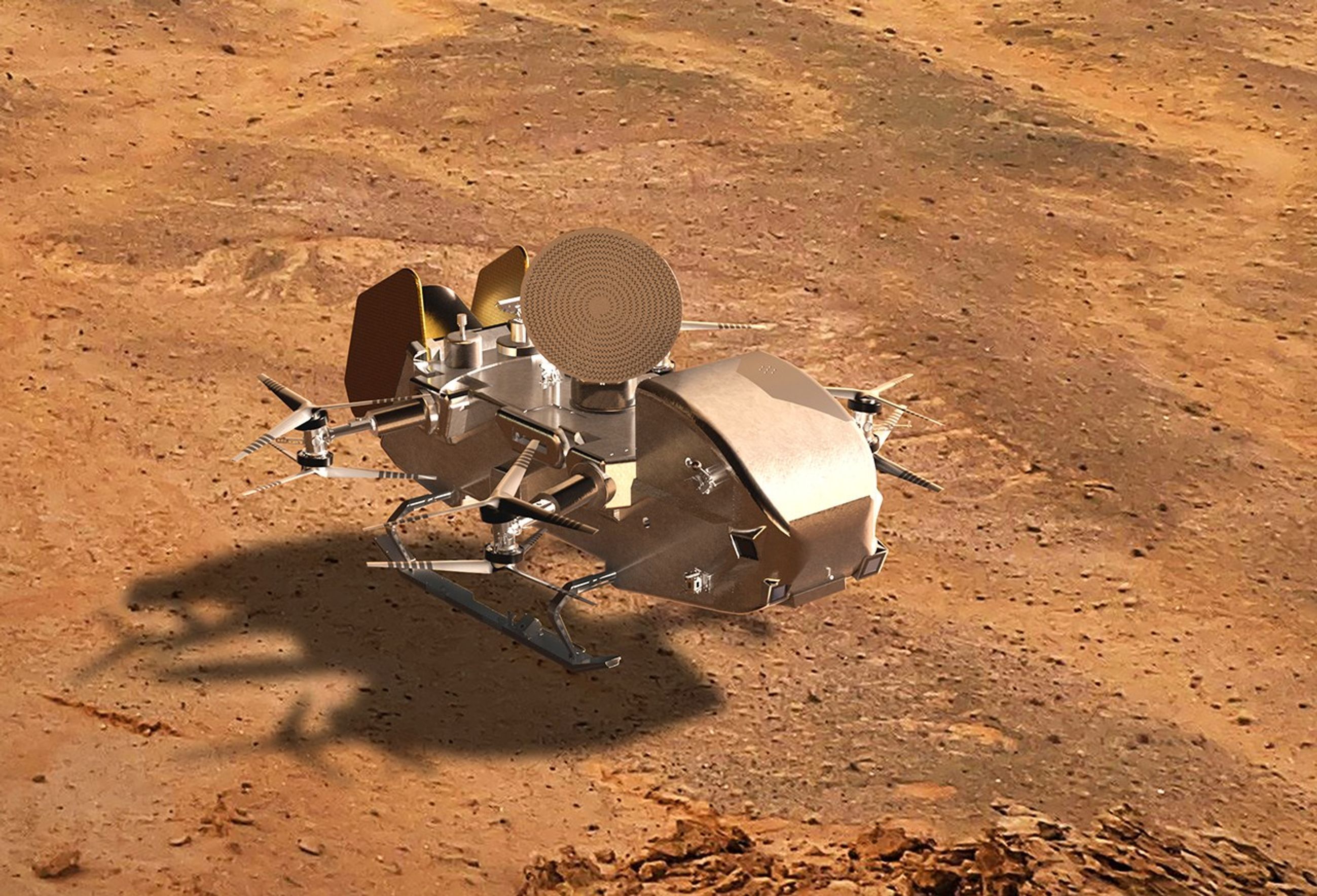
But not everything is as familiar as it seems. At minus 292 degrees Fahrenheit, the dune sands aren’t silicate grains but organic material. The rivers, lakes and seas hold liquid methane and ethane, not water. Titan is a frigid world laden with organic molecules.
Yet Dragonfly, a car-sized rotorcraft set to launch no earlier than 2028, will explore this frigid world to potentially answer one of science’s biggest questions: How did life begin?
Seeking answers about life in a place where it likely can’t survive seems odd. But that’s precisely the point.
“Dragonfly isn’t a mission to detect life — it’s a mission to investigate the chemistry that came before biology here on Earth,” said Zibi Turtle, principal investigator for Dragonfly and a planetary scientist at the Johns Hopkins Applied Physics Laboratory in Laurel, Maryland. “On Titan, we can explore the chemical processes that may have led to life on Earth without life complicating the picture.”
On Earth, life has reshaped nearly everything, burying its chemical forebears beneath eons of evolution. Even today’s microbes rely on a slew of reactions to keep squirming.
“You need to have gone from simple to complex chemistry before jumping to biology, but we don’t know all the steps,” Turtle said. “Titan allows us to uncover some of them.”
Titan is an untouched chemical laboratory where all the ingredients for known life — organics, liquid water and an energy source — have interacted in the past. What Dragonfly uncovers will illuminate a past since erased on Earth and refine our understanding of habitability and whether the chemistry that sparked life here is a universal rule — or a wonderous cosmic fluke.
Before NASA’s Cassini-Huygens mission, researchers didn't know just how rich Titan is in organic molecules. The mission’s data, combined with laboratory experiments, revealed a molecular smorgasbord — ethane, propane, acetylene, acetone, vinyl cyanide, benzene, cyanogen, and more.
These molecules fall to the surface, forming thick deposits on Titan’s ice bedrock. Scientists believe life-related chemistry could start there — if given some liquid water, such as from an asteroid impact.
Enter Selk crater, a 50-mile-wide impact site. It’s a key Dragonfly destination, not only because it’s covered in organics, but because it may have had liquid water for an extended time.
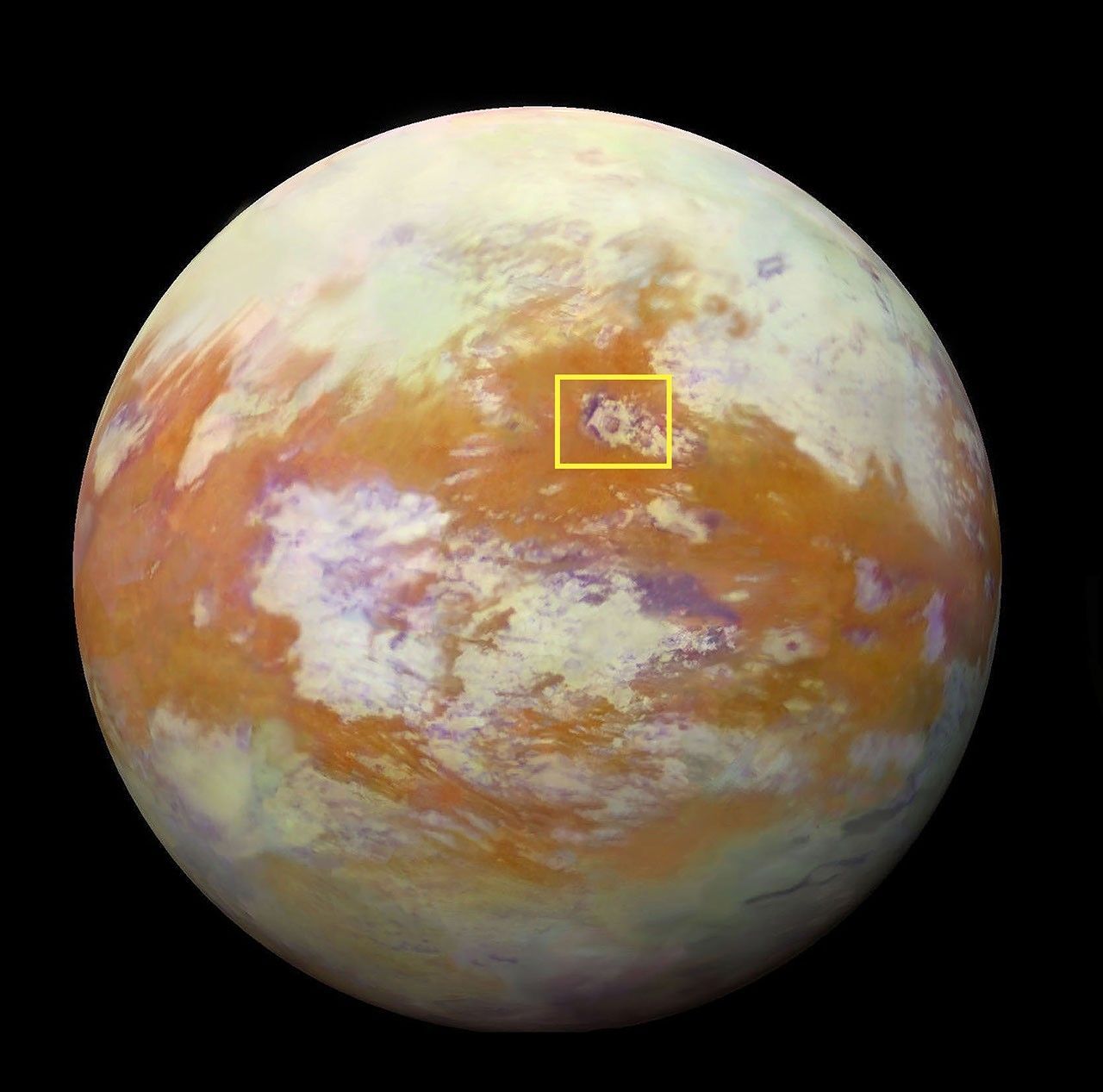
The impact that formed Selk melted the icy bedrock, creating a temporary pool that could have remained liquid for hundreds to thousands of years under an insulating ice layer, like winter ponds on Earth. If a natural antifreeze like ammonia were mixed in, the pool could have remained unfrozen even longer, blending water with organics and the impactor’s silicon, phosphorus, sulfur and iron to form a primordial soup.
“It’s essentially a long-running chemical experiment,” said Sarah Hörst, an atmospheric chemist at Johns Hopkins University and co-investigator on Dragonfly’s science team. “That’s why Titan is exciting. It’s a natural version of our origin-of-life experiments — except it’s been running much longer and on a planetary scale.”
For decades, scientists have simulated Earth’s early conditions, mixing water with simple organics to create a “prebiotic soup” and jumpstarting reactions with an electrical shock. The problem is time. Most tests last weeks, maybe months or years.
The melt pools at Selk crater, however, possibly lasted tens of thousands of years. Still shorter than the hundreds of millions of years it took life to emerge on Earth, but potentially enough time for critical chemistry to occur.
“We don’t know if Earth life took so long because conditions had to stabilize or because the chemistry itself needed time,” Hörst said. “But models show that if you toss Titan’s organics into water, tens of thousands of years is plenty of time for chemistry to happen.”
Dragonfly will test that theory. Landing near Selk, it will fly from site to site, analyzing the surface chemistry to investigate the frozen remains of what could have been prebiotic chemistry in action.
Morgan Cable, a research scientist at NASA’s Jet Propulsion Laboratory in Southern California and co-investigator on Dragonfly, is particularly excited about the Dragonfly Mass Spectrometer (DraMS) instrument. Developed by NASA’s Goddard Space Flight Center in Greenbelt, Maryland, with a key subsystem provided by the CNES (Centre National d'Etudes Spatiales), DraMS will search for indicators of complex chemistry.
“We’re not looking for exact molecules, but patterns that suggest complexity,” Cable said. On Earth, for example, amino acids — fundamental to proteins — appear in specific patterns. A world without life would mainly manufacture the simplest amino acids and form fewer complex ones.
Generally, Titan isn’t regarded as habitable; it’s too cold for the chemistry of life as we know it to occur, and there’s is no liquid water on the surface, where the organics and likely energy sources exist.
Still, scientists have assumed that if a place has life’s ingredients and enough time, complex chemistry — and eventually life — should emerge. If Titan proves otherwise, it may mean we’ve misunderstood something about life’s start and it may be rarer than we thought.
“We won’t know how easy or difficult it is for these chemical steps to occur if we don’t go, so we need to go and look,” Cable said. “That’s the fun thing about going to a world like Titan. We’re like detectives with our magnifying glasses, looking at everything and wondering what this is.”
Dragonfly is being designed and built under the direction of the Johns Hopkins Applied Physics Laboratory (APL), which manages the mission for NASA. The team includes key partners at NASA’s Goddard Space Flight Center and NASA’s Jet Propulsion Laboratory. Dragonfly is managed by NASA’s Marshall Space Flight Center in Huntsville, Alabama, for the agency’s Science Mission Directorate at NASA Headquarters in Washington.
Quelle: NASA



